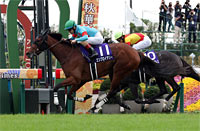Shuka Sho (G1) - Data Analysis
Final leg of the Japanese Fillies’ Triple Crown
The Oka Sho and the Yushun Himba (Japanese Oaks) were both contested in the spring season. With the summer now behind us, the Shuka Sho will bring runners to the turf of Kyoto Racecourse for the final leg of the Triple Crown for three-year-old fillies this autumn. The question now is whether the title will go to a runner that turned in strong performance in the spring season, or to a runner that has achieved growth over the summer. Let’s now analyze some features shared by successful runners in this race based on results over the last 10 years, including the 2021 and 2022 races held at Hanshin Racecourse.
Runners with a Top 3 finish in their previous race have the edge
The last 10 winners had all finished in the Top 3 of their previous race. In addition, 25 of the 30 Top 3 finishers had also finished in the Top 3 of their previous race, and runners with a Top 3 finish in their previous race across all groups achieved higher success ratios than runners that had finished 4th or lower. Furthermore, runners that had finished 6th or lower in their previous race only produced one Top 3 finisher, so we should sharply lower our expectations of runners with such a record. [Table 1]
[Table 1] Performance by finish in the previous race (last 10 years)
| Finish in previous race |
Performance
[1st-2nd-3rd-4th or lower] |
Win ratio |
Top 2 ratio |
Top 3 ratio |
| 1st |
5-4-5-38 |
9.6% |
17.3% |
26.9% |
| 2nd |
4-0-2-17 |
17.4% |
17.4% |
26.1% |
| 3rd |
1-3-1-15 |
5.0% |
20.0% |
25.0% |
| 4th, 5th |
0-3-1-19 |
0% |
13.0% |
17.4% |
| 6th-9th |
0-0-1-25 |
0% |
0% |
3.8% |
| 10th or lower |
0-0-0-29 |
0% |
0% |
0% |
Favoritism in the previous race is also a key factor
Looking at performances by runners over the last 10 years in terms of favoritism in their previous race, we find that the 10 winners had been all backed as 3rd favorite or higher in their previous race. Runners that had been backed as 1st or 2nd favorite also achieved Top 3 ratios of over 30%, so higher favoritism in the previous race appears to translate into higher success ratios for this race. We should therefore firmly check the finish and favoritism of runners in their previous race. [Table 2]
[Table 2] Performance by favoritism in the previous race (last 10 years)
| Favoritism in previous race |
Performance
[1st-2nd-3rd-4th or lower] |
Win ratio |
Top 2 ratio |
Top 3 ratio |
| 1st favorite |
7-2-2-23 |
20.6% |
26.5% |
32.4% |
| 2nd favorite |
2-3-2-16 |
8.7% |
21.7% |
30.4% |
| 3rd favorite |
1-1-1-11 |
7.1% |
14.3% |
21.4% |
| 4th, 5th favorite |
0-2-3-28 |
0% |
6.1% |
15.2% |
| 6th-9th favorite |
0-2-1-38 |
0% |
4.9% |
7.3% |
| 10th favorite or lower |
0-0-1-27 |
0% |
0% |
3.6% |
Watch the position when passing the 4th corner in the previous race
Looking at performances by runners over the last 10 years in terms of the position when passing the 4th corner in their previous race, we observe that runners that had been positioned 10th or lower produced five winners, and secured the highest Win ratio. The group that delivered the next highest number of winners (four) were runners that had been positioned 5th to 9th when passing the 4th corner in their previous race. These runners made up 17 of the 30 Top 3 finishers, and also achieved a high Top 3 ratio. Conversely, runners that had been positioned 4th or higher produced seven Top 3 finishers, but struggled somewhat with a Top 3 ratio of 9.7%. [Table 3]
[Table 3] Performance by position when passing the 4th corner in the previous race (last 10 years)
Position when passing 4th
corner in previous race |
Performance
[1st-2nd-3rd-4th or lower] |
Win ratio |
Top 2 ratio |
Top 3 ratio |
| 4th or higher |
1-3-3-65 |
1.4% |
5.6% |
9.7% |
| 5th-9th |
4-6-7-45 |
6.5% |
16.1% |
27.4% |
| 10th or lower |
5-1-0-33 |
12.8% |
15.4% |
15.4% |
Strong performers in the spring Triple Crown races fare well
Looking at performances by runners over the last 10 years in terms of the highest finish in the spring Classic races (Oka Sho and Japanese Oaks), we find that runners that had finished in the Top 2 of either the Oka Sho or the Japanese Oaks achieved a Top 3 ratio of over 50%. In addition, runners that had finished 3rd in those races achieved a high Top 3 ratio of 42.9%. This suggests we should first sharply raise our expectations of runners that have risen to the top in the two races of the spring season. Meanwhile, nine runners that had not entered the spring Triple Crown races also finished in the Top 3. We should therefore also closely look at runners that have gained strength over the summer. [Table 4]
[Table 4] Performance by highest finish in the Oka Sho or Japanese Oaks (last 10 years)
| Highest finish |
Performance
[1st-2nd-3rd-4th or lower] |
Win ratio |
Top 2 ratio |
Top 3 ratio |
| 1st |
4-1-1-5 |
36.4% |
45.5% |
54.5% |
| 2nd |
2-2-3-5 |
16.7% |
33.3% |
58.3% |
| 3rd |
1-2-0-4 |
14.3% |
42.9% |
42.9% |
| 4th |
1-1-0-6 |
12.5% |
25.0% |
25.0% |
| 5th |
0-1-0-10 |
0% |
9.1% |
9.1% |
| 6th or lower |
0-0-2-54 |
0% |
0% |
3.6% |
| No entry in either race |
2-3-4-59 |
2.9% |
7.4% |
13.2% |
Focus on record in an open-class race within the last two outings
The last 10 winners had contested at least one open-class race within the last two outings, and had finished in the Top 4 of all applicable such races. We should therefore look for a win contender among runners that have enjoyed success in a recent open-class race. [Table 5]
[Table 5] Winners’ finish in an open-class race within the last two outings (last 10 years)
| Year |
Winner |
Finish in open-class race within last two outings |
| 2014 |
Shonan Pandora |
Shion Stakes (Shuka Sho Trial) 2nd |
| 2015 |
Mikki Queen |
Kansai Telecasting Corp. Sho Rose Stakes (Shuka Sho Trial) 2nd,
Yushun Himba (Japanese Oaks) 1st |
| 2016 |
Vivlos |
Shion Stakes (Shuka Sho Trial) 2nd |
| 2017 |
Deirdre |
Shion Stakes (Shuka Sho Trial) 1st |
| 2018 |
Almond Eye |
Yushun Himba (Japanese Oaks) 1st, Oka Sho 1st |
| 2019 |
Chrono Genesis |
Yushun Himba (Japanese Oaks) 3rd, Oka Sho 3rd |
| 2020 |
Daring Tact |
Yushun Himba (Japanese Oaks) 1st, Oka Sho 1st |
| 2021 |
Akaitorino Musume |
Yushun Himba (Japanese Oaks) 2nd, Oka Sho 4th |
| 2022 |
Stunning Rose |
Shion Stakes (Shuka Sho Trial) 1st, Yushun Himba (Japanese Oaks) 2nd |
| 2023 |
Liberty Island |
Yushun Himba (Japanese Oaks) 1st, Oka Sho 1st |
(Michio Kawano)
|


















